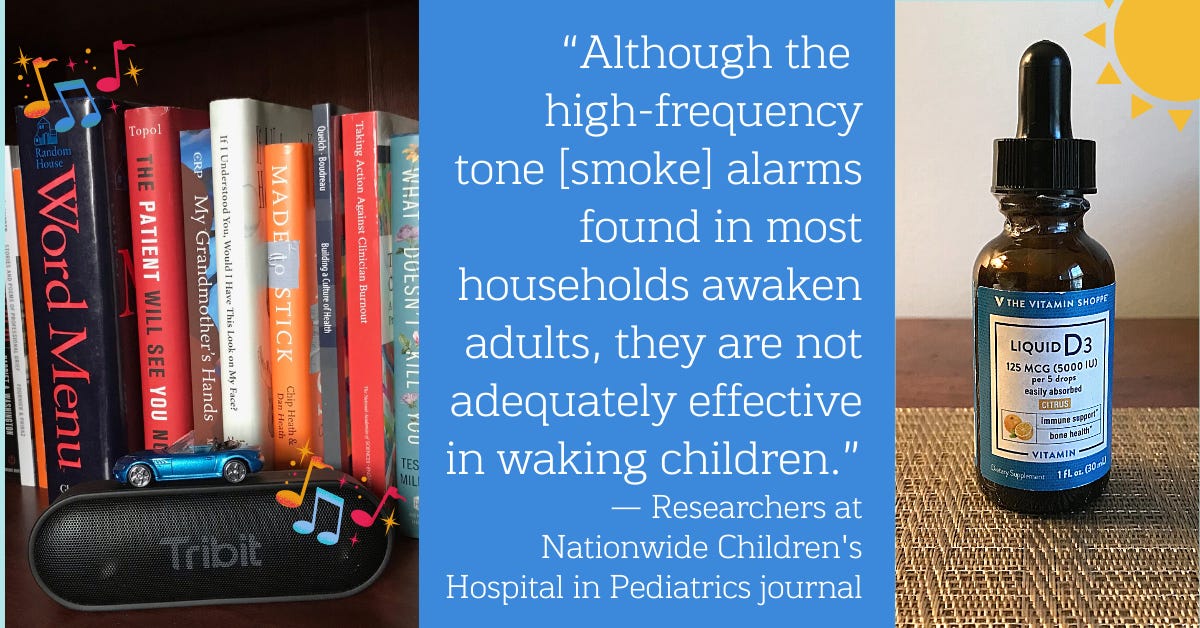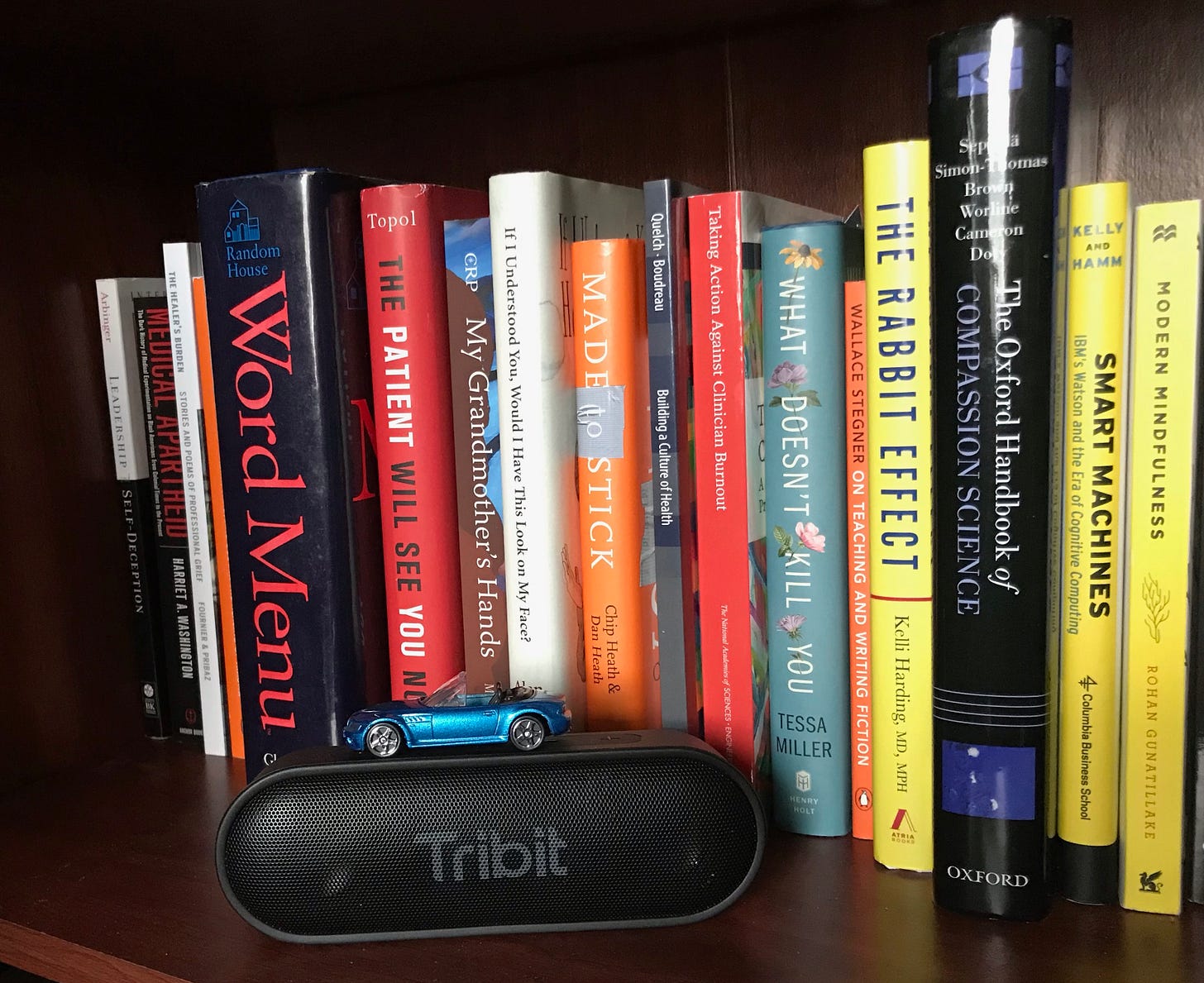Field Notes #15
A small and mighty music speaker; smoke alarms that do and don’t wake up children; potent vitamin D drops
Hello, friends! I’m wondering what kind of Field Notes are most interesting or helpful to you. If I go exploring, what direction should I head? Where in your life would you like a few ideas for your health and well-being? You can reply to this email, comment on the post, or email brianne@daybreaknotes.com. I really would love to know about any area you are struggling with and could use a few ideas. Consider this an invitation to be your personal reporter/detective.
1} Smoke alarms that don’t wake up young children
A fascinating and rather shocking (to me) study came out this week in the journal Pediatrics looking at what kinds of smoke alarms successfully wake children who are 5-12 years old.
Our smoke alarm is incredibly loud. I can’t imagine sleeping through it.
Well, it turns out that many kids can sleep through smoke alarms, especially younger children. What?! Yes, really. But it depends on the type of alarm.
This study included 540 kids and four types of smoke alarms: human voice, low-frequency tone (500 Hz), high-frequency tone (3200 Hz), and a voice-tone mix. Most U.S. homes have smoke alarms with the high-frequency tone, that familiar shrill blare.
In the study, children fell asleep in a research room that looked like an ordinary bedroom. Electrodes were attached to each child to monitor their sleep. Once they fell into the deepest sleep stage, the researchers triggered one of the four alarms. The researchers tracked how long it took the child to wake up and how long it took them to exit out a door, which marked “time-to-escape.”
The difference in response by age and by tone was enormous.
The conventional, high-frequency tone was by far the worst. At 3 minutes of that alarm blaring, 72% of 5 years olds were still asleep!
Year by year, the older kids woke up to the alarms more easily. But even at age 12, the oldest age in the test, 24% of kids were still asleep after 3 minutes.
The voice alarm and the hybrid low-frequency tone/voice did the best. The researchers tested three kinds of voices — a male voice, a female voice, and the child’s own mother, all saying “Fire! Fire! Wake up! Get out of bed! Leave the room!” They thought the mother’s voice might be more effective, but there were no major differences. This was also the first study to look at whether boys and girls are affected by the four types of alarms differently — no, they weren’t.
View a chart of the findings by age and time.
The “time-to-escape” did vary dramatically by age and tone.
The study says: “Fire safety professionals warn that individuals have as little as 1 to 2 minutes to escape after a smoke alarm sounds.”
For 5-year-olds, just 25% got out of the room in less than 2 minutes when the high-frequency tone alarm went off. With the other alarm types, 53-68% escaped.
For 12-year-olds, 68% got out of the room in under 2 minutes with the high-frequency tone alarm. With the other alarm types, 90-100% escaped.
But the high-frequency tone alarm is what most U.S. houses have! How can this be? Low-frequency tone alarms became the standard for commercial sleeping rooms, like hotels, in 2014, says the study. But homes are still mainly using high-frequency tones.
When I wrote to the lead author, Dr. Gary Smith of Nationwide Children’s Hospital in Columbus, Ohio, to ask about what model of hybrid voice/low-frequency alarm he used in the study, because I couldn’t find anything like that in the online shops, he told me they created their own by using a Simplex 1996, 4100 Fire Alarm (this seems to be a commercial alarm) and the voice of someone affiliated with the study. “Hopefully, manufacturers will now make such alarms available in the marketplace,” he wrote. (My journalism and entrepreneurial friends, there is a story and a business opportunity here!)
Read the full study here: Age-Dependent Responsiveness to Smoke Alarm Signals Among Children
2} Tiny but mighty music speaker
I’m still working remotely. And I’ve been noticing the silence in the house throughout the day, between Zoom calls, and wanting to do something about it. Music brightens my mood. Music mixes up the ordinary day. Music fills a near-empty house.
For a while, I was propping my laptop on the bookshelf next to my work computer. It was fine, but the sound wasn’t great. A few people had recommend Sonos or similar speakers, but I don’t love how they use Siri or Alexa. Far-off computers listening in gives me the creeps.
After a bit of searching, I ran across a simpler speaker, the Tribit XSound Go, which has an old-fashioned audio plug and a more modern Bluetooth connection, but no AI eavesdropper. It was $32, and I was a little wary. But it’s really quite great! The Bluetooth syncs up easily. The sound out of this tiny speaker is voluptuous. (It’s still not on par with an expensive stereo system, but it’s a noticeable step up from the tinny computer speakers.)
Bonus: The speaker is portable, with no power cord. (A built-in battery needs to be recharged by USB cord, though I haven’t had to do that yet.) I can move it by my work station, into the kitchen while I cook dinner, and outside when we are hanging out with friends.
Two of the stations I’ve been tuning into regularly now (from my phone or laptop beamed via Bluetooth to the speaker) are WYNC’s New Standards Stream (mostly jazz standards, updated) and Bluegrass Country Radio (88.5 FM in the D.C. area). Both are wonderful mood elevators.
Do you find music soothing or energizing during the day? What’s your set-up or favorite tunes?
3} Vitamin D drops
Vitamin D is tricky to write much about. Some argue that a substantial portion of people are vitamin D deficient, in part due to our indoor living and declining levels of sun exposure; others say that there’s an overblown and quite problematic vitamin D craze underway.
According to NIH in this vitamin D primer, “In the United States, most people have adequate blood levels of vitamin D. However, almost one out of four people have vitamin D blood levels that are too low or inadequate for bone and overall health.”
I tried to research this more thoroughly for you and ended up throwing up my hands. Talk to your doctor, my friends!
But if your doctor orders bloodwork, and your vitamin D levels are very low and your doctor recommends you use a Vitamin D supplement, then this is what I would pass along to you as an option. (Again, talk to your doctor!)

Vitamin Shoppe Vitamin D liquid drops
Five drops is a dose. Five drops!
It’s inexpensive. ($8.99 for 236 doses at the lowest level, 1,000 IU or 25 mcg per 5 drops.) It comes in three strengths. (The lowest strength seems more than sufficient, at 125% of your recommended daily allowance.) It tastes rather lovely, because it has citrus oil in it. (Sometimes I’ll put drops on my scrambled eggs or avocado toast, for instance.) And it doesn’t require swallowing a giant pill.
After using 5 drops daily, my vitamin D levels went from under 10 to around 100. “50+ nmol/L “is adequate for most people for bone and overall health,” reports NIH, while levels under 30 nmol/L “are too low and might weaken your bones and affect your health.”
After my vitamin D levels soared, my own doctor actually advised I back off the vitamin D drops a bit, so I use it less often now. But still, I was grateful to find something easy, tasty, effective, and inexpensive. Perhaps it might be helpful to you, too. Again, ask your doctor! I am not a doctor — just your friendly independent writer and health aficionado.
I hope you have an wonderful rest of the week filled with rays of music and sunshine.
To our journeys,
Brianne





